Abstract
Persistent infections by rabies virus in BHK-21/13S and HEp-2 cells were studied comparatively. No evidence of interferon production, selection of virus-resistant cells, or integration of the viral genome could be found. Persisting viruses replicated efficiently at 34, 36, and 40 degrees C. Both persistently infected cultures released defective interfering virus particles. A cyclical pattern of infection, which was not characteristic of the persistently infected HEp-2 system, was observed in persistently infected BHK cultures. The virus from persistently infected BHK cultures lost its virulence for mice, whereas the virus from persistently infected HEp-2 cultures retained mouse-killing capacity for more than 3 years.
Full text
PDF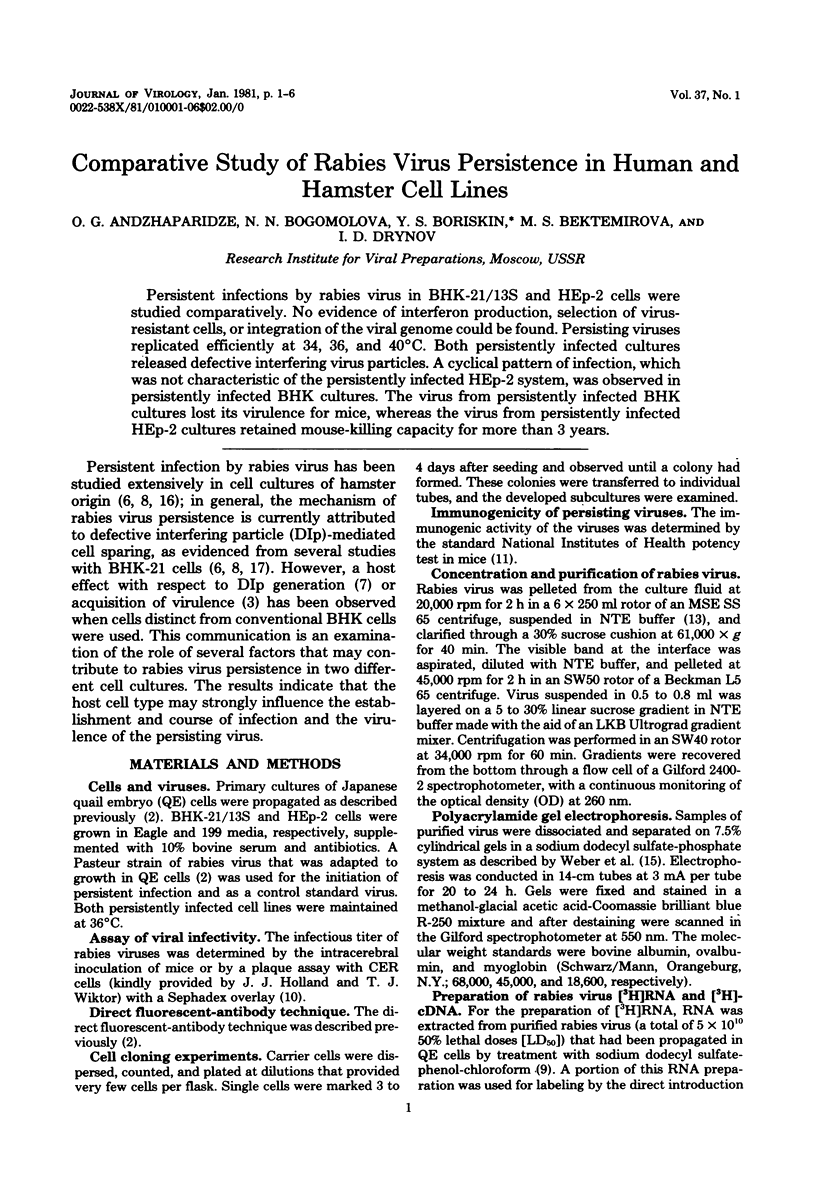
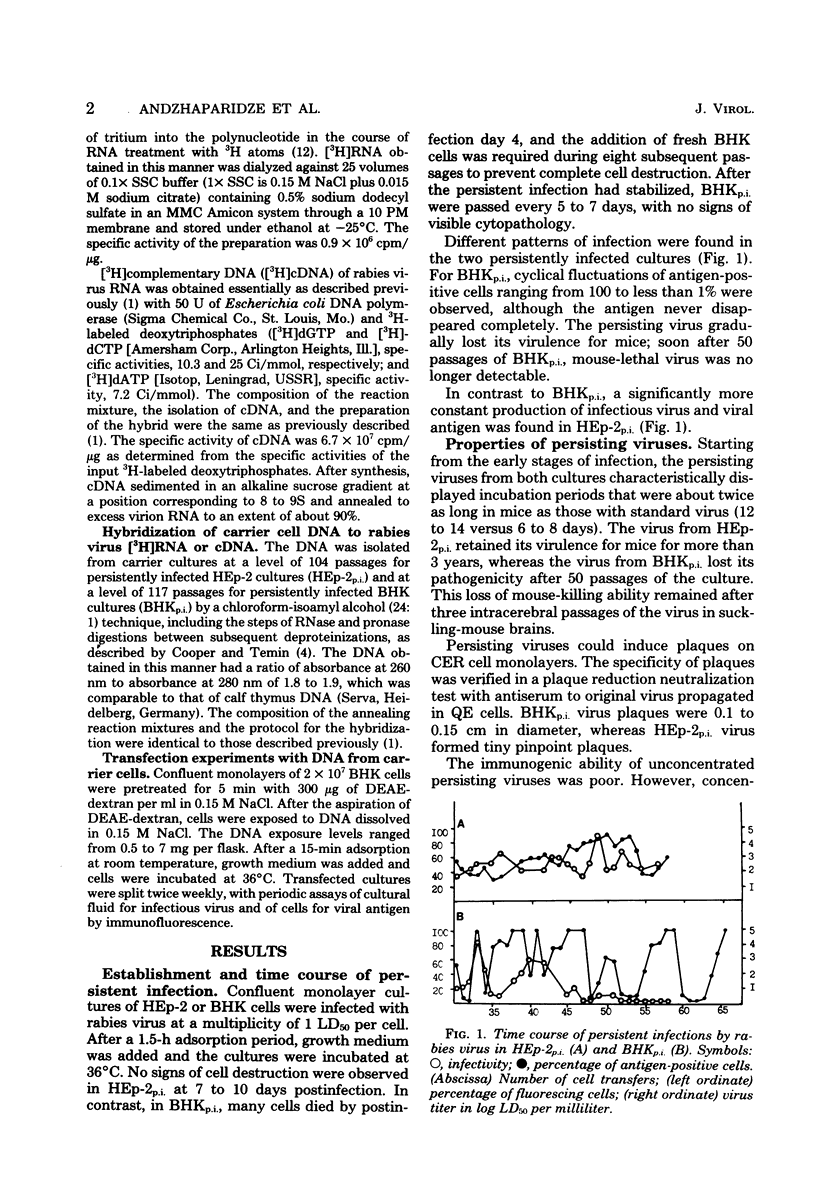
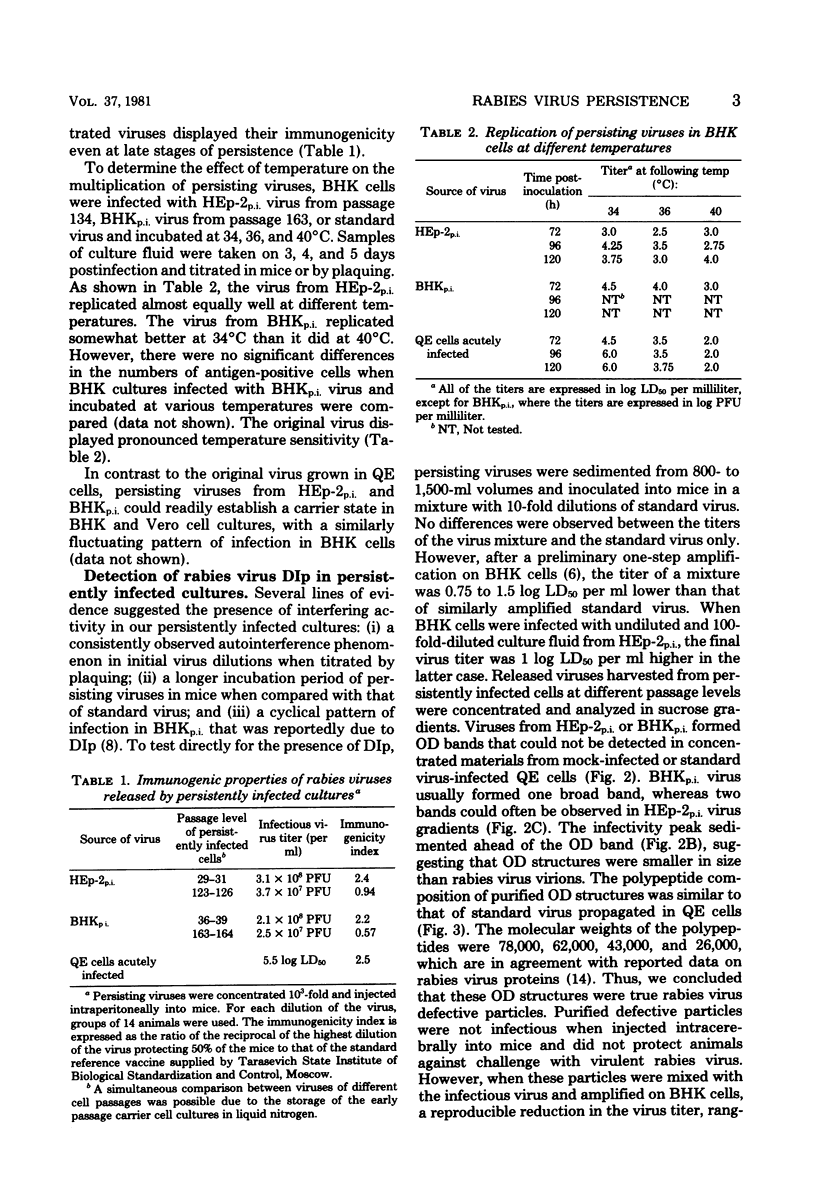
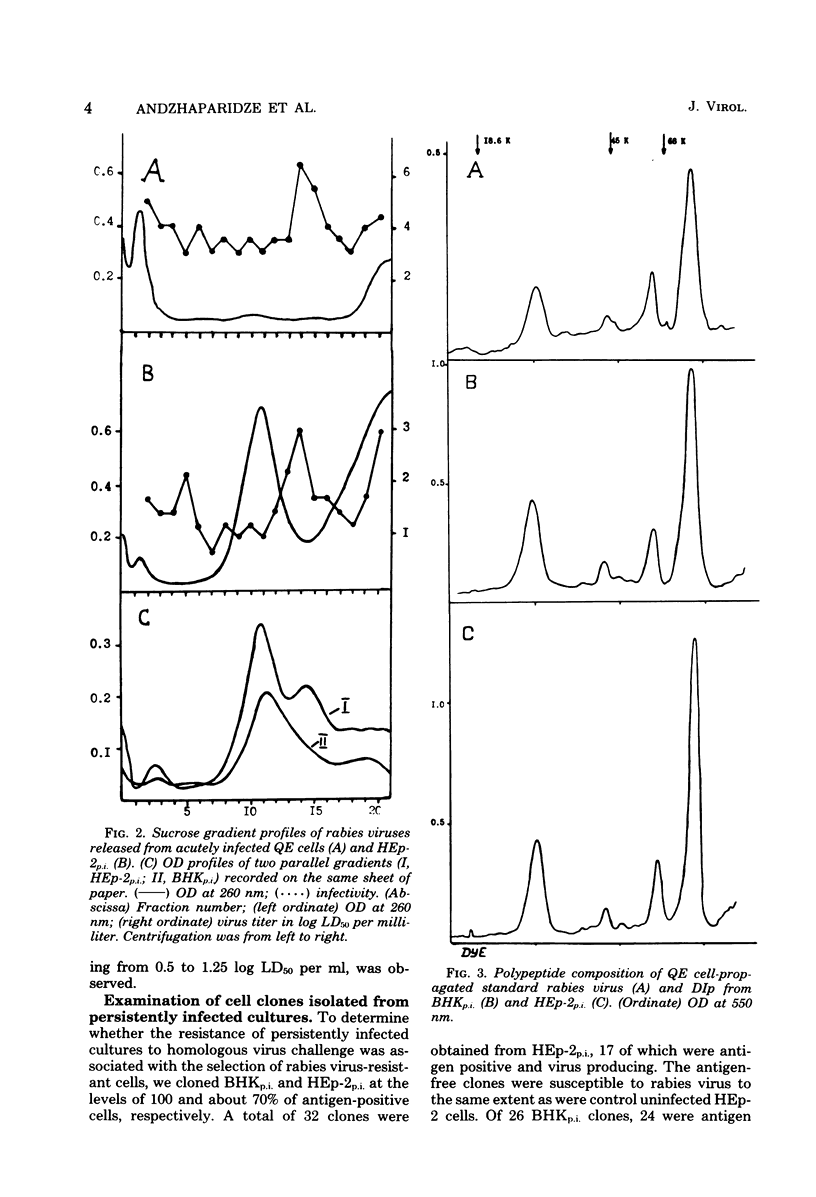
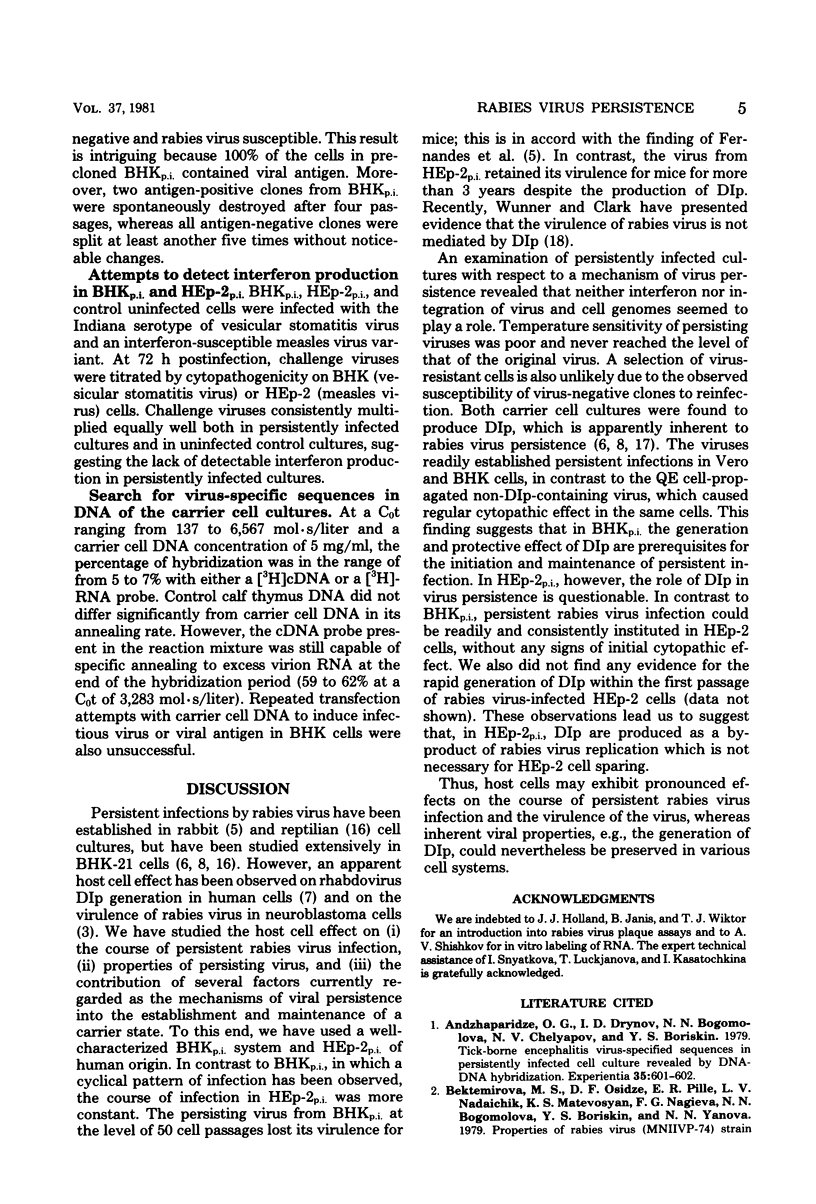

Selected References
These references are in PubMed. This may not be the complete list of references from this article.
- Andzhaparidze O. G., Drynov I. D., Bogomolova N. N., Chelyapov N. V., Boriskin Y. S. Tick-borne encephalitis virus-specified sequences in persistently infected cell culture revealed by DNA-DNA hybridization. Experientia. 1979 May 15;35(5):601–602. doi: 10.1007/BF01960344. [DOI] [PubMed] [Google Scholar]
- Bektemirova M. S., Osidze D. F., Pille E. R., Nadaichik L. V., Matevosyan K. S., Nagieva F. G., Bogomolova N. N., Boriskin Y. S., Yanova N. N. Properties of rabies virus (MNIIVP-74 strain) adapted to Japanese quail embryo cell culture. Arch Virol. 1979;61(1-2):61–68. doi: 10.1007/BF01320592. [DOI] [PubMed] [Google Scholar]
- Clark H. F. Rabies viruses increase in virulence when propagated in neuroblastoma cell culture. Science. 1978 Mar 10;199(4333):1072–1075. doi: 10.1126/science.628831. [DOI] [PubMed] [Google Scholar]
- Cooper G. M., Temin H. M. Infectious rous sarcoma virus and reticuloendotheliosis virus DNAs. J Virol. 1974 Nov;14(5):1132–1141. doi: 10.1128/jvi.14.5.1132-1141.1974. [DOI] [PMC free article] [PubMed] [Google Scholar]
- FERNANDES M. V., WIKTOR T. J., KOPROWSKI H. ENDOSYMBIOTIC RELATIONSHIP BETWEEN ANIMAL VIRUSES AND HOST CELLS. A STUDY OF RABIES VIRUS IN TISSUE CULTURE. J Exp Med. 1964 Dec 1;120:1099–1116. doi: 10.1084/jem.120.6.1099. [DOI] [PMC free article] [PubMed] [Google Scholar]
- Holland J. J., Villarreal L. P., Breindl M. Factors involved in the generation and replication of rhabdovirus defective T particles. J Virol. 1976 Mar;17(3):805–815. doi: 10.1128/jvi.17.3.805-815.1976. [DOI] [PMC free article] [PubMed] [Google Scholar]
- Holland J. J., Villarreal L. P. Purification of defective interfering T particles of vesicular stomatitis and rabies viruses generated in vivo in brains of newborn mice. Virology. 1975 Oct;67(2):438–449. doi: 10.1016/0042-6822(75)90445-6. [DOI] [PubMed] [Google Scholar]
- Kawai A., Matsumoto S., Tanabe K. Characterization of rabies viruses recovered from persistently infected BHK cells. Virology. 1975 Oct;67(2):520–533. doi: 10.1016/0042-6822(75)90452-3. [DOI] [PubMed] [Google Scholar]
- Perry R. P., La Torre J., Kelley D. E., Greenberg J. R. On the lability of poly(A) sequences during extraction of messenger RNA from polyribosomes. Biochim Biophys Acta. 1972 Mar 14;262(2):220–226. doi: 10.1016/0005-2787(72)90236-5. [DOI] [PubMed] [Google Scholar]
- Schneider L. Laboratory techniques in rabies: cell monolayer plaque test. Monogr Ser World Health Organ. 1973;(23):339–342. [PubMed] [Google Scholar]
- Seligmann E. B., Jr Laboratory techniques in rabies: the NIH test for potency. Monogr Ser World Health Organ. 1973;(23):279–286. [PubMed] [Google Scholar]
- Sokol F., Kuwert E., Wiktor T. J., Hummeler K., Koprowski H. Purification of rabies virus grown in tissue culture. J Virol. 1968 Aug;2(8):836–849. doi: 10.1128/jvi.2.8.836-849.1968. [DOI] [PMC free article] [PubMed] [Google Scholar]
- Sokol F., Stancek D., Koprowski H. Structural proteins of rabies virus. J Virol. 1971 Feb;7(2):241–249. doi: 10.1128/jvi.7.2.241-249.1971. [DOI] [PMC free article] [PubMed] [Google Scholar]
- Wiktor T. J., Clark H. F. Chronic rabies virus infection of cell cultures. Infect Immun. 1972 Dec;6(6):988–995. doi: 10.1128/iai.6.6.988-995.1972. [DOI] [PMC free article] [PubMed] [Google Scholar]
- Wiktor T. J., Dietzschold B., Leamnson R. N., Koprowski H. Induction and biological properties of defective interfering particles of rabies virus. J Virol. 1977 Feb;21(2):626–635. doi: 10.1128/jvi.21.2.626-635.1977. [DOI] [PMC free article] [PubMed] [Google Scholar]


